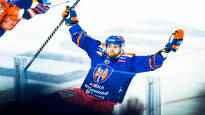Tappara has focused on increasing skating and fighting power in training. It was seen as an airplane in the trough and especially in the third batches.
28.4. 21:41 • Updated April 28th. 21:49
Tappara, who won the Finnish championship, returned spectacularly to the Finnish Champions League this season. The people of Tampere first took the regular season and finally also the gold in a way that left little room for joss.
Tappara won 12 games in the playoffs and lost only three times. The decisive Thursday final ended with Tappara 1–0 and the series went to the champions 4–1.
Tappara’s mastery can be broken down in many ways, but the importance of physics cannot be overemphasized. It is best revealed in the statistics on third items. Tappara is completely superior to everyone else in the finals. The ax group has won more than 60 percent of the third installments in the regular season and playoffs.
– We have invested in being able to handle the rest of the exchanges, the rest of the games and the rest of the games, says Tappara’s physics coach Konsta Karjalainen.
He forms the second physics coach of the Iron Trio Tommi Pärmäkoski and test manager Marko Haverisen with.
Good physics has a long tradition in Tappara. They extend Kalevi Numminen and Rauno Korven times, and traditions have been cherished as well Jukka Rautakorven and Jussi Tapolan during.
A year ago, Tappara bowed to Luko in the semifinals and was left without a medal. As a conclusion from the season, Tapola announced that in Tappara, sportiness must be restored to the center. An experienced pilot announced the power of skating and fighting.
Things weren’t in the back, but Tappara wasn’t the best in the series either. At the same time, Tapola talked about the culture of practice, which he felt ruined.
One of the most important decisions was to bring physics coaching even closer to the players ’daily lives. The Karelian has been present throughout the season. Pärmäkoski is responsible for the big lines and the planning of the internship. Haverinen of Varala Sports College, on the other hand, monitors training and development.
The hockey player must be durable, fast and strong. Perfectly fitting these qualities to one athlete is not an easy equation.
– If you place too much emphasis on a feature, then it’s out of nowhere. If, for example, you invest too much in force, it may be off the sustainability side, Karjalainen explains.
Proper training, monitoring of load and recovery, as well as various tests can ensure that the job stays on track.
Let’s start with practice. Haverinen brings up a pitfall that must be able to dodge. Attempts are being made to improve the game through ice training, but at the same time, the average power load can become unnecessarily high.
– Extremes, ie basic aerobic endurance as well as speed and strength training, must be dosed sensibly alongside sports training and games, Haverinen emphasizes.
In terms of individual needs and team training, you also need to be okay. Even a killer can accommodate a wide variety of players. Some are in the early stages of their careers, while others have years-long foundations.
Karjalainen mentions a 23-year-old defender from the younger guard Santtu Kinnusen, which is focused on gaining strength and getting more meat from its body. It is directly visible on the ice. Kinnunen has developed considerably in the struggles.
Kristian Kuuselan, 39, the needs are very different from the youth department. The world champion has been very sharp this season.
– In the first place, an experienced player needs their own motivation to develop themselves, strong training stimuli for continued development and special attention to ensure recovery, Haverinen explains.
Perceiving the whole is essential in monitoring the load and recovery. Tappara monitors players’ heart rate and movement in ice practice and games. In addition, Tappara’s players assess the strain of the training themselves through their own knowledge. Jump tests, on the other hand, tell you about the state of your nervous system.
In the fall, some of Tappara’s players were in “red,” meaning they didn’t fully recover from the hard training and game load. Towards the end of the season, the players had a flight.
Haverinen started working at Tappara in 2015. The team’s physical development curve during the season has now looked steeper upwards than ever.
– Individual development during the season is an important thing. It’s more essential than comparing test scores between different seasons, however, when the lineup always changes somewhat.
The team’s style of play must also be taken into account in training. Tappara relies on versatility. It is capable of both retreating and defending the center as well as squeezing greedily deep at the opponent’s end.
That is, once again there will be a sacred covenant of endurance, speed, and power. Physics has to enable endurance, struggles and different ways of playing. This Tappara has been exceptionally successful.
This also pleases the demanding Tapola.
– The physics team has received good feedback. The bile has not come, Karjalainen smiles.
